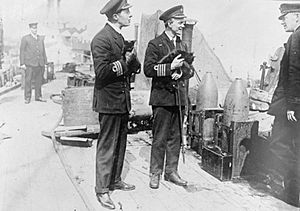Alfred Carpenter facts for kids
Quick facts for kids
Alfred Francis Blakeney Carpenter
|
|
|---|---|

Alfred Carpenter by Arthur Stockdale Cope
|
|
| Born | 17 September 1881 Barnes, Surrey |
| Died | 27 December 1955 (aged 74) |
| Allegiance | |
| Service/ |
|
| Years of service | 1898 - 1934 |
| Rank | Vice Admiral |
| Commands held | HMS Vindictive |
| Battles/wars | 1898 Occupation of Crete Boxer Rebellion World War I World War II |
| Awards | Victoria Cross Légion d'honneur Croix de Guerre (France) |
Alfred Francis Blakeney Carpenter was a brave officer in the Royal Navy. He is famous for being awarded the Victoria Cross. This is the highest and most respected award for courage. It is given to British and Commonwealth forces for bravery against the enemy. He earned it for his amazing actions during a daring mission in World War I.
Contents
About Alfred Carpenter's Family
Alfred Carpenter was born in Barnes, England, in 1881. His father, also named Alfred Carpenter, was a Captain in the Royal Navy. His grandfather was Commander Charles Carpenter. Alfred went to Bedales School. In 1903, he married Emily Maud Mary Tordiffe. After she passed away, he married Hilda Margaret Allison Smith in 1927.
Alfred Carpenter joined the Royal Navy in 1898. He served as a midshipman in Crete that year. He also saw action during the Boxer Rebellion in China around 1900-1901.
By 1901, he was an acting sub-lieutenant. In 1902, he was on HMS Havock. This was for the Coronation Fleet review. Later that year, he joined HMS Cleopatra. This ship was used for training new sailors. He became a specialist in navigation from 1903. He was even thanked by the Admiralty for some of his inventions. He also received a medal for saving lives at sea.
World War I Heroics
During World War I, he worked for Admiral Jellicoe from 1914 to 1915. He was promoted to Commander in 1915. From 1915 to 1917, he was the navigating officer of HMS Emperor of India.
The Zeebrugge Raid and the Victoria Cross
On April 22-23, 1918, Captain Carpenter was in command of HMS Vindictive. This ship was part of a very risky mission called the Zeebrugge Raid. The plan was to land 200 Royal Marines on a long wall, or mole, at Zeebrugge in Belgium.
Captain Carpenter showed incredible bravery during this attack. He calmly guided his ship through dangerous waters filled with mines. He brought the ship right alongside the mole in the dark. Even when the enemy fired heavily at his ship, he stayed calm. He encouraged everyone around him. He walked around the ship, directing the landing of troops. He also cheered on his men in the most dangerous spots. His leadership and courage greatly helped the mission succeed.
Because of his amazing actions, Captain Carpenter was chosen to receive the Victoria Cross. This was a special selection made by the officers and men of his ship, Vindictive, and other ships involved. This was allowed under a special rule (Rule 13) for when everyone is equally brave.
Post-War Career
After the war, Captain Carpenter continued his service. He commanded HMS Carysfort from 1921 to 1923. He was also Captain of Chatham Dockyard from 1924 to 1926. He commanded HMS Benbow in 1926 and HMS Marlborough from 1927 to 1928.
He became an honorary naval aide-de-camp to King George V in 1929. In the same year, he was promoted to Rear-Admiral and retired. He was promoted to Vice-Admiral (retired) in 1934. During World War II, he commanded a section of the Home Guard in Gloucestershire.
His Victoria Cross medal is now on display at the Imperial War Museum in London, England.


